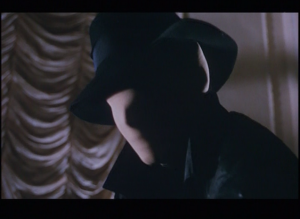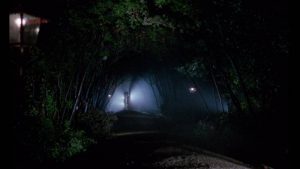Cult Criterion is a series that focuses on cult, horror and exploitation films that are available on DVD and Blu-Ray. Though some well known titles may be given attention, some that tend to get ignored will also get attention.
The giallo is one of the quintessential cult movie genres. Something that genre aficionados and cinephiles know and love, but is largely unknown to the general public in spite of it’s influence. Everything from slasher movies to the films of Tim Burton (“Sweeney Todd” owes a debt to the genre in it’s look and style), Guillermo Del Toro (his recent film “Crimson Peak” has a murder scene that is blatantly inspired by the genre) Darren Aronofsky and Nicolas Winding Refn (it could be argued that “Black Swan” and “The Neon Demon” are modern day versions of the genre) are inspired by or probably wouldn’t exist is it wasn’t for it. Hell, read this for a sampling of movies inspired by the giallo.
So, what exactly is a giallo movie? To start, it was a genre of mystery/horror that originated in Italy. Named after a series of mystery novels that had yellow book covers (giallo is Italian for yellow), they were popular worldwide in drive-in and Grindhouse theaters, but were especially popular in their home country. From the mid 60’s to the early 80’s, the country made insane amounts of these movies-with other entries coming from countries like Spain (Blue Eyes of the Broken Doll starring Euro Horror icon Paul Naschy) Britain (In the Devil’s Garden) China (Corpse Mania) Japan (Evil Dead Trap and it’s pseudo sequel) and even the U.S. (several Brian De Palma films, including Dressed to Kill) . It mostly died around the late 80’s, with only a few titles popping up every now and then.

If the giallo movie has a father, his name would be Mario Bava. Though he also dabbled in Spaghetti Westerns, Sword and Sandal movies, Spy Capers (“Danger: Diabolique”) and even sex comedies (the “Doctor Goldfoot” movies starring Vincent Price), he is mostly known for his horror movies. Along with Riccardo Freda, he basically created the Italian horror movie with Lust of the Vampire before moving on to the likes of Black Sabbath (yes, that is where the band got their name) and other influential titles. I could go on and on about his influence, so instead of wasting your time with that, you could read this for a taste of who owes a debt to his work. Needless to say, he’s an important director in general.
In 1963, Bava directed The Girl Who Knew Too Much, which was the first true giallo movie. The story (a woman witnesses a murder and finds herself caught between a series of killings) owed more of a debt to Alfred Hitchcock, but managed to stand out thanks to it’s gorgeous cinematography, inventive twists and striking black and white photography. However, it was his second take on the genre that was the real game changer. That film was Blood and Black Lace (now out on Arrow Video/MVD Visual) and the world of horror (and the thriller) would soon take notice.
The film opens with a woman being murdered at night by a masked man (or is it a woman?) Said woman was a model at a fashion house , which is run by Max (genre mainstay and character actor Cameron Mitchell) and his girlfriend Cristina (Eva Bartok). During the investigation, stories involving drugs, abortion and blackmail begin to pile up, and lo and behold, it seems like the murdered woman was keeping an eye of these things and putting them in her journal. In the process, the killer wants this journal, and the next thing you know more dead bodies begin to pile up.

While “The Girl Who Knew Too Much” set forth the blueprint, “Blood and Black Lace” planted the seed. Nearly every giallo film (and plenty of movies outside of said sub genre) took notes and borrowed from it. The look of the killer, the sleazy Jazz inflicted score, the cinematography, the “So, who is the killer really?” aspect of the movie-everybody from Dario Argento to Lucio Fulci probably wouldn’t have the careers they had if it weren’t for this movie.
I mentioned the look of the killer in particular because as you may notice from the above picture, you don’t see their face. Indeed, many a giallo went out to hid the identity of the killer-and the same could be said of the killer. Sure, you might not see the face of Leatherface, and for a split second you see what Michael Myers looks like in “Halloween”, but they still wear a mask-if anything, the masked/hidden villain in the slasher movie owes a huge debt to this move. Another thing the slasher film owes a large debt to is the murders. They aren’t the goriest death scenes, but they are noticeably brutal and operatic at the same time. Indeed, the increasingly violent murder sequences clearly rubbed off on later movies.

Also worthy of note is the use of colors. One of the things the giallo is usually known for is the use of bright primary colors that create a sense of nightmarish psychedelia-indeed, like you are watching somebodies nightmare. Many a giallo would borrow this template from the movie, but here it is especially noticeable. When Bravo aired it’s “100 Scariest Movie Moments” special nearly twelve years ago, this movie was mentioned. Joe Dante (director of “Piranha” and the “Gremlins” films, among others) mentioned how film students would obsess over it, and legendary horror author Ramsey Campbell brought up how the use of colors and lighting are so crucial. Look at the above picture. The use of lighting, fog and soon after colors manage to, to slightly paraphrase Mr. Campbell, make the night seem that much darker and foreboding.
This wouldn’t be the last time Bava entered the world of the giallo. Later entries would include the psychedelic mystery 5 Dolls for an August Moon, the Gothic tinged Hatchet for the Honeymoon and the gory, darkly comic A Bay of Blood. The latter title is especially worthy of note, as it serves among one of the earliest examples of the slasher movie*, what with it’s bloody but creative kills, so called “rules” of the genre (i.e. don’t do drugs or have sex) and noticeably larger body count. As Q-Tip once said, things go in cycles.
I mentioned Lucio Fulci and Dario Argento-the other most popular Italian horror directors-for a good reason BTW. That’s because after this, they would do their own takes on the giallo. For Fulci, it would be the likes of A Lizard in Woman’s Skin, Don’t Torture a Duckling and the sleazy, nihilistic giallo/slasher hybrid The New York Ripper as examples. Argento on the other hand, has spent much of his career making giallo movies-he might as well be the king of the genre. I say that because he managed to take this formula in films like his debut The Bird with the Crystal Plumage and his later work and expand on them. Nonetheless, as I said-no Mario Bava, no Fulci and Argento.

Needless to say, there is no reason whatsoever to not watch or own this movie. It’s absolutely essential viewing, both for horror fans, those looking to get into the world of Italian cult cinema, and movie lovers in general. It is also one of the finest-hell, maybe the finest-film in the crazy world of the giallo movie. So, what the hell are you waiting for? Go watch it.
*Other examples include Narciso Ibáñez Serrador’s The House That Screamed, Jim O’Connolly’s Tower of Evil and Bob Clark’s Black Christmas.

